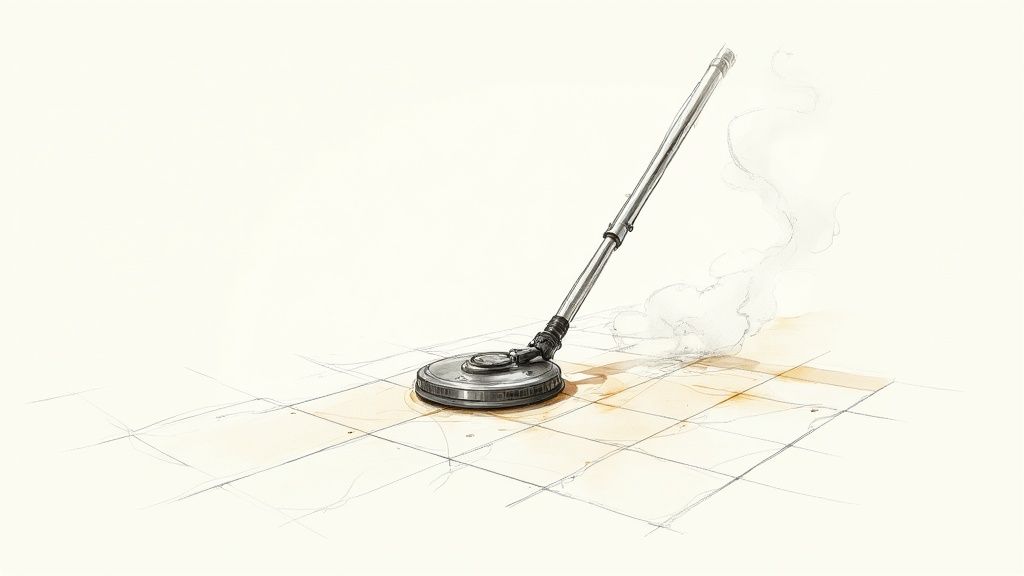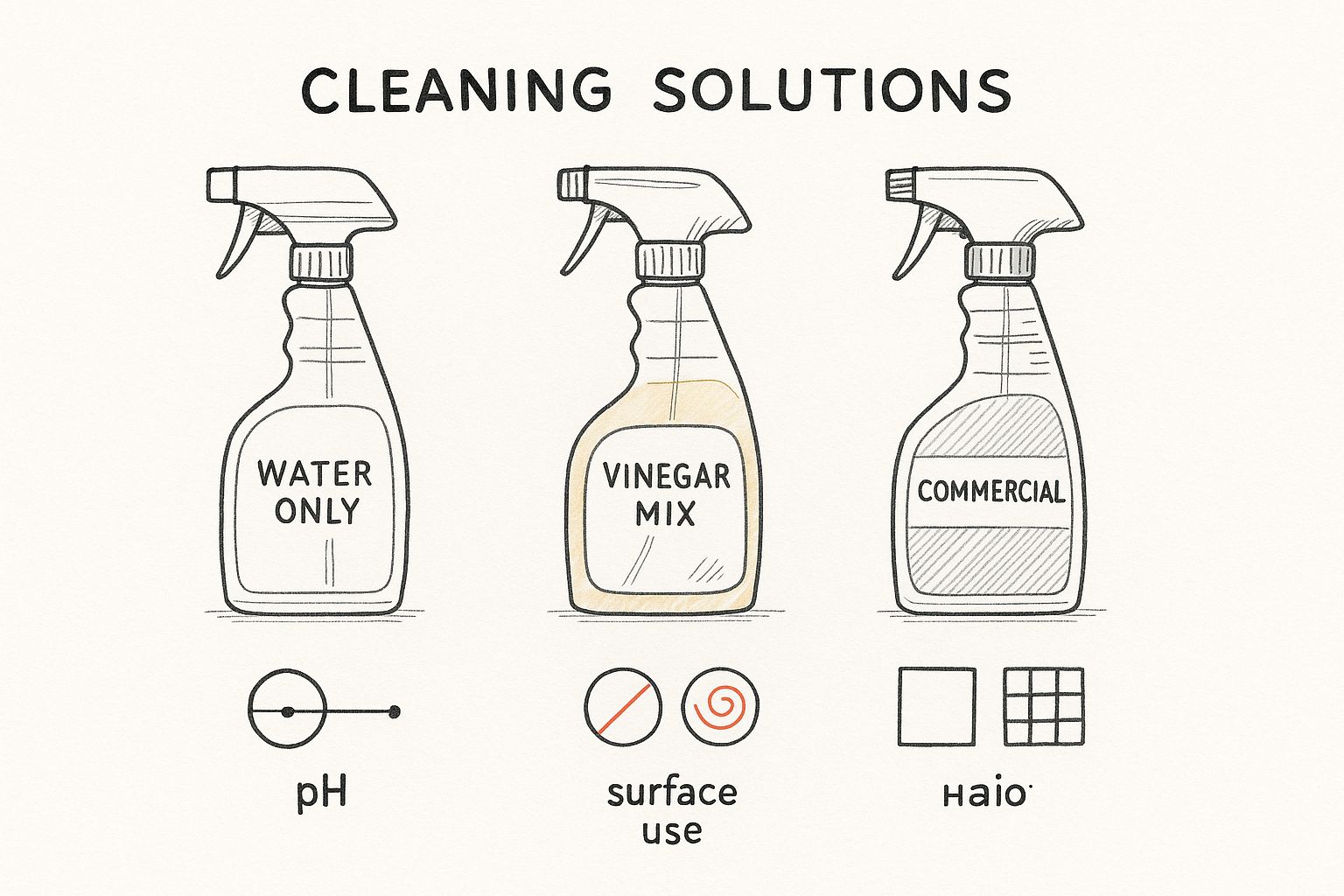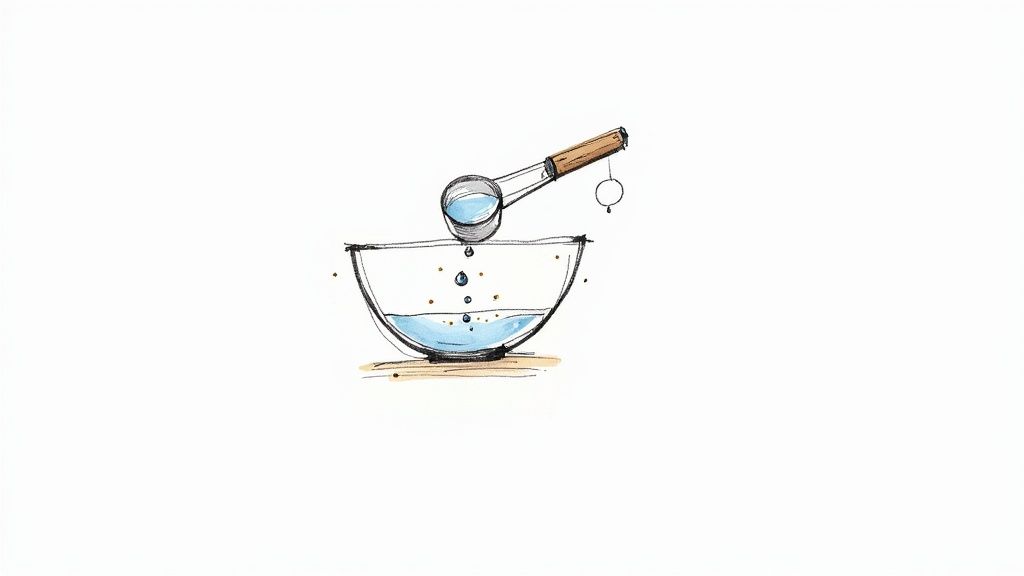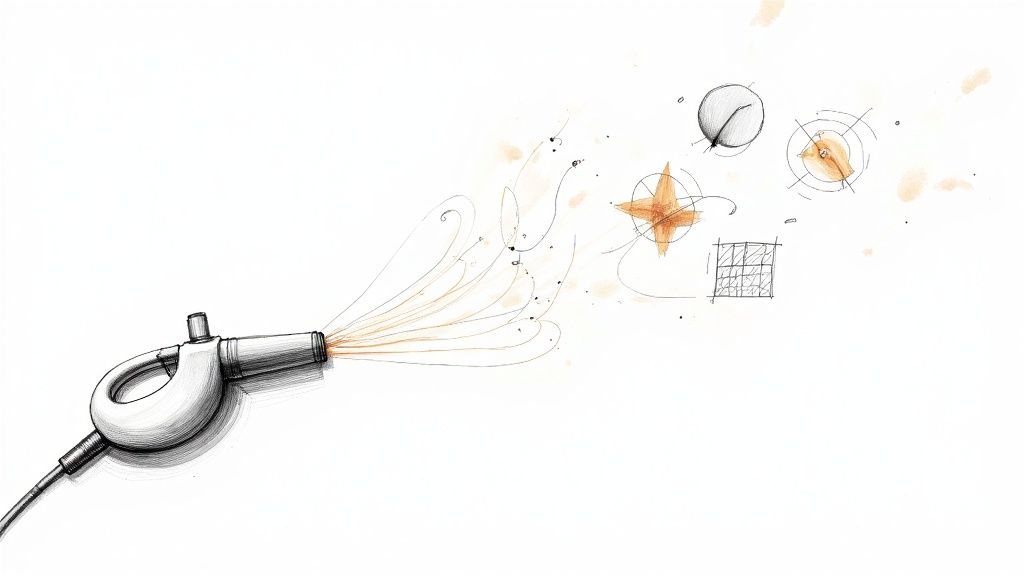Fed up with stubborn grime and that sharp, chemical smell that lingers after cleaning? What if the best cleaning solution wasn't a cocktail of chemicals, but just plain water? That’s the simple-yet-powerful idea behind steam cleaning, which turns ordinary tap water into a superheated, sanitising force that deep cleans without any toxic aftermath.
A Healthier Home, Unlocked by Steam
Picture this: getting your home sparkling clean using nothing more than hot vapour. This is the magic of modern steam cleaning, a method that’s quickly winning over everyone from professional cleaners to busy homeowners. It's a way to ditch the cluttered cupboard of chemical sprays for one single, highly effective tool.
The process itself is surprisingly simple. A steam cleaner heats water far beyond boiling, often pushing it to 120°C or even higher. This creates a very hot, low-moisture vapour. When you point this pressurised steam at a surface, it gets to work in two brilliant ways.

How Steam Obliterates Grime and Germs
First, that intense heat melts away grease and loosens dirt that’s been baked on for ages. It works by breaking down the very bonds that hold the muck to the surface. It’s a bit like running a hot knife through cold butter – the grime just gives way, making it effortless to wipe away messes that would normally need some serious elbow grease and harsh chemicals.
Second, and this is where it gets really clever, the high temperature is a natural sanitiser.
The heat from a quality steam cleaner can kill up to 99.9% of common household bacteria, viruses, and allergens like dust mites. This is thermal sanitation at its best, giving you a level of clean that chemicals often can't, all without leaving any nasty residue behind.
This one-two punch of cleaning and sanitising is what really makes steam stand out. It tackles the dirt you can see and the germs you can't, making your home a genuinely healthier place to be. If you've got kids, pets, or anyone in the family with allergies or chemical sensitivities, this is a game-changer. You get total peace of mind, knowing your home is disinfected the natural way.
How Steam Actually Gets Things So Clean
To really get why steam cleaning works so well, you have to appreciate the simple science behind it. Forget thinking about traditional mops and sprays; this is more like giving your surfaces a deep-cleansing, high-pressure facial. It all starts with turning regular tap water into a powerful cleaning tool.
A steam cleaner takes water way past its boiling point, often pushing it to 120°C or even higher. This creates a superheated, low-moisture vapour that we often call ‘dry steam’. When this pressurised steam hits a surface, the magic happens. The tiny water vapour molecules are minuscule compared to a droplet from a spray bottle, letting them get deep into microscopic pores and cracks that cloths and chemical cleaners just glide right over.
Breaking Down Grime on a Molecular Level
The real star of the show is the intense heat. It works by instantly shattering the bonds that make dirt, grease, and grime cling to surfaces. Think about trying to get stubborn grease off a pan with cold water versus hot water – the heat does all the heavy lifting. Steam just takes that idea to a whole new level, melting away tough messes without any need for harsh scrubbing or nasty chemicals.
This molecular breakdown means dirt and other gunk can be wiped away with a simple microfibre cloth, leaving the surface looking brand new. It’s a game-changer for those notoriously tricky spots:
- Tile Grout: Steam effortlessly blasts out the grime and mildew that collects in porous grout lines.
- Oven Grease: Baked-on food and grease that would usually need a powerful chemical solvent just dissolve under the heat.
- Upholstery Stains: The steam gets right into the fabric fibres, releasing trapped dirt and getting rid of lingering odours from pets or spills.
The Power of Thermal Sanitising
But steam cleaning goes beyond what you can see. It delivers a much deeper level of hygiene. The sheer temperature of the vapour is a powerful weapon against the invisible germs and allergens hiding around your home. We call this thermal sanitising.
When you use it properly, the heat from a steam cleaner can kill up to 99.9% of common household bacteria, viruses, germs, and allergens like dust mites and mould spores.
And the best part? It does all this without a single drop of chemical disinfectant. That’s a massive plus for anyone with children, pets, or sensitivities to harsh chemicals. The surface isn't just visibly clean; it's hygienically clean, which helps create a much healthier home. Because the steam has so little moisture, surfaces also dry in minutes, stopping mould and mildew from getting the damp environment they need to grow.
Choosing the Right Steam Cleaner for Your Home
Picking the right steam cleaner can feel a bit like choosing a new car; you've got different models, and each one is built for a specific purpose. Getting your head around the main types is the first real step to finding the perfect fit for your home and making sure your steam cleaning solutions really deliver.
Broadly speaking, you're looking at three main players: canister steam cleaners, steam mops, and handheld steamers. Each has its own set of talents, making it better suited for certain jobs and spaces.
Let's break down what each type does best to help you decide.
The All-Rounder: Canister Steam Cleaners
Think of a canister steam cleaner as the versatile estate car of the cleaning world. These machines have a separate, large water tank (usually on wheels) connected to a long hose, which lets you swap out various attachments. It’s this design that gives them their power and makes them brilliant for big, deep-cleaning missions.
Their bigger tanks mean you can keep going for longer without needing to stop and refill, which is a massive plus when you’re tackling an entire room or several different surfaces at once.

The Swift and Simple: Steam Mops
If the canister cleaner is an estate car, then the steam mop is a nimble city runaround. It’s lightweight, compact, and designed for one main job: zipping across sealed hard floors. They look and feel a lot like a standard mop, but they pack the punch of hot steam to lift dirt and sanitise as they go.
They heat up in a flash, making them your go-to for everyday spills and regular floor cleaning. For many, they're the ideal replacement for the old mop and bucket, giving you a far more hygienic clean without leaving any chemical residue behind.
One of the best things about a steam mop is how quickly the floors dry. Because they use 'dry' steam with very little moisture, a freshly cleaned floor is often ready to walk on in minutes—a huge improvement on traditional mopping.
The Precise and Portable: Handheld Steamers
Handheld steam cleaners are the compact multitools of the steam world. They're small, portable, and easy to grab for those quick, targeted jobs where a bigger machine would just be a nuisance. They really shine when it comes to getting into tight spots and dealing with smaller, specific messes.
These little gadgets are incredibly handy for tasks that need a bit more precision and a lot more convenience. You wouldn’t use one to clean a whole floor, but for spot-cleaning and tricky areas, they’re second to none.
A Comparison of Steam Cleaner Types
To make the choice even clearer, here’s a straightforward look at how the different types stack up against each other.
| Cleaner Type | Best For | Pros | Cons |
|---|---|---|---|
| Canister Steam Cleaner | Large areas, deep cleaning multiple surfaces, heavy-duty jobs | Powerful, versatile with attachments, long cleaning time | Bulky, requires more storage space, longer heat-up time |
| Steam Mop | Regular cleaning of sealed hard floors (wood, tile, laminate) | Lightweight, easy to store, heats up quickly, affordable | Limited to floors, smaller water tank, less powerful |
| Handheld Steamer | Small, targeted tasks, tight spaces, upholstery, grout lines, sanitising | Very portable, convenient for quick jobs, heats up instantly | Very small tank, not for large areas, less overall power |
Ultimately, the best steam cleaner is the one that fits your lifestyle and the cleaning challenges you face most often.
For those much larger, more demanding jobs, sometimes it’s worth calling in the professionals. If you're looking for expert help, you can find out more about booking professional cleaning services in Oxford to handle the heavy lifting. It's a great way to enjoy a pristine home without all the effort.
Right then, let's talk about what really happens when you switch to steam cleaning. It’s about more than just getting things to sparkle; you're actually making a smart move for your family's health, your bank account, and the planet.
For most people, the biggest win is creating a genuinely healthier home. Instead of just smearing chemicals around or covering up smells, steam gets right to the root of the problem and blasts it away. This is a massive relief for anyone with allergies, asthma, young children, or pets. The high-temperature vapour gives you a deep, sanitising clean with absolutely no chemical nasties left behind.
A Healthier Home
Think about the typical cleaning cupboard. It’s often full of harsh chemicals that can irritate lungs and release volatile organic compounds (VOCs) into the air you breathe. Steam cleaning is different. It's just superheated water doing all the hard work.
By using nothing more than water, steam cleaning wipes out up to 99.9% of common germs, bacteria, and allergens like dust mites and mould spores. This is proper thermal sanitation, giving you real peace of mind that your home isn't just tidy, it's hygienically clean.
This is a game-changer for families. You can let your toddler crawl around on a floor that's been disinfected by heat, not by a lingering chemical spray. If you're a pet owner, you can finally tackle those stubborn odours in the carpet without worrying about your furry friend licking up harmful residues.
Big Savings in the Long Run
I know what you're thinking – a steam cleaner costs a fair bit more than a bottle of all-purpose spray. And you're right, there's an initial outlay. But when you look at the bigger picture, the long-term savings are huge.
Just take a peek under your sink. You’ve probably got a whole collection of different bottles for different jobs:
- Floors: One cleaner for tiles, another for your sealed hardwood.
- Kitchens: A heavy-duty degreaser for the hob and a separate spray for the worktops.
- Bathrooms: Something for mould, a specific grout cleaner, and another for glass.
- Fabrics: Upholstery shampoos and little spot treatments for spills.
A good steam cleaner can replace almost all of them. Your only running costs are a tiny bit of electricity and a splash of tap water. Over the course of a year, the money you save by not buying all those specialised products really adds up. You’ll free up your budget and reclaim some serious cupboard space.
Plus, you're doing your bit for the environment by cutting down on all that single-use plastic. It’s a choice that’s as kind to your wallet as it is to the planet.
Mastering Your Steam Cleaning Technique
So, you've got the right tool for the job. Now it's time to put it to work. Getting that professional-level finish isn't about brute force; it's all about technique and a little bit of prep. A bit of groundwork makes a world of difference, ensuring the steam can lift dirt and sanitise surfaces without a hitch.
The most important first step? Clear the area. Think of it like painting a room—you need a clean canvas to start. Give the surface a good vacuum first to get rid of any loose hair, dust, and debris. If you try to steam a floor covered in crumbs, you’ll just end up with a soggy, smeared mess.
Once you've prepped the surface, you can get to the main event. The real secret to success is picking the right attachment for the task at hand.
Choosing the Right Tool for the Job
Your steam cleaner probably came with an arsenal of attachments, and each one has a specific job. Using the right one doesn't just make the work easier; it makes it far more effective.
- Jet Nozzle: This little powerhouse concentrates steam into a fine, powerful stream. It’s perfect for blasting grime out of tile grout, getting around taps, and cleaning other tight crevices.
- Squeegee Attachment: Your best friend for windows, mirrors, and glass shower screens. It cleans and clears away the moisture in one smooth motion, leaving a brilliant, streak-free shine.
- Floor Head with Microfibre Pad: This is your go-to for sealed hard floors. The wide head lets you cover ground quickly, while the pad mops up all the dislodged dirt.
- Small Brushes: These usually clip onto the jet nozzle and are fantastic for scrubbing stubborn, stuck-on grime from oven hobs, BBQ grills, or tiles.

Common Mistakes to Avoid
Knowing what not to do is just as crucial as knowing what to do. A few simple errors can lead to disappointing results or, worse, damaged surfaces. Keep an eye out for these common pitfalls.
The secret to great steam cleaning isn’t speed; it’s patience. By moving the cleaner slowly and steadily, you give the steam enough time to really break down the dirt and kill 99.9% of germs. Rushing just won't give the heat enough time to work its magic.
Another classic mistake is forgetting about the microfibre pads. As you clean, these pads soak up an incredible amount of filth. If you don't swap them out when they get saturated, you're just spreading that grime right back onto the surface you’re trying to clean.
And finally, always test a small, hidden spot first. This is especially true for sensitive materials like upholstery or certain types of flooring. Most importantly, never use a steam cleaner on unsealed surfaces like untreated hardwood, non-waterproof laminate, or porous stone. The high-pressure moisture can cause them to warp, swell, or suffer permanent damage. For really tough, set-in messes on fabrics, you might want to look into how to remove stubborn stains before you bring in the heat.
This methodical, effective approach to cleaning is catching on. In 2023, there were 75,565 cleaning businesses in the UK, an increase from 73,655 the previous year. It’s clear that the demand for a proper, deep clean is on the rise. You can find more insights into the UK cleaning industry over on Policybee.
Essential Safety Guidelines for Steam Cleaners
When you’re wielding the power of high-temperature steam, a healthy dose of respect is non-negotiable. While steam cleaning solutions are brilliant at what they do, you've got to use them correctly to sidestep any accidents. The number one rule is just common sense: never, ever point the nozzle at a person, a pet, or even your favourite houseplant. That steam is hot enough to cause a nasty burn in an instant.
It's also crucial to let the machine cool down completely before you even think about refilling the water tank or swapping out an attachment. Opening a pressurised system too early can unleash a dangerous blast of scalding water and steam. Trust me, taking a few extra minutes for it to cool is a small price to pay for your safety.
Surfaces to Steer Clear Of
Not every surface in your home is cut out for the intense heat and moisture that a steam cleaner delivers. To avoid that sinking feeling of having ruined something, keep your machine away from these materials.
- Unsealed Porous Surfaces: Think unsealed wood, terracotta, and some natural stone. Steam can force moisture deep into the pores, leading to warping, swelling, or permanent water damage.
- Delicate Fabrics: Silk, velour, and certain thin plastics just can't take the heat. You'll risk melting or permanently damaging them.
- Freshly Painted or Papered Walls: The heat can make fresh paint bubble up and cause wallpaper glue to fail, completely ruining the finish.
Following these essential guidelines ensures you can enjoy a sanitised home without any unintended consequences. It’s about working smart and respecting the power of the tool in your hands.
This thoughtful approach to cleaning is catching on. As more people look for eco-friendly methods, the global steam cleaning service market is projected to hit an estimated $25,000 million by 2025. This shows a real shift towards safer, chemical-free options. You can find more insights about this growing market over on datainsightsmarket.com.
Your Top Steam Cleaning Questions Answered
It's completely normal to have a few questions before you dive into the world of steam cleaning. After all, you want to be sure you're getting it right and making the most of this chemical-free cleaning method. Let's walk through some of the queries we hear most often.
A big one for many homeowners is, "Will steam cleaning damage my grout?" It’s a great question, but you can put your mind at ease. Far from causing harm, high-pressure steam is actually one of the kindest and most powerful ways to restore your grout lines. Unlike acidic chemicals that can literally eat away at grout over time, steam gets deep into the pores to blast out grime and kill mould, all without any abrasive damage.
Water, Drying, and Getting the Best Results
"Can I just use tap water in my machine?" is another common query. While you can, it's not always the best idea for the long-term health of your cleaner.
We always recommend using distilled or demineralised water, particularly if you're in a hard water area. This simple step prevents limescale and other mineral deposits from building up inside your machine, which keeps it running efficiently and extends its life. For more practical advice like this, you'll find plenty of expert tips on our Signal Cleaning blog.
Finally, what about drying times? This is where steam cleaning truly shines.
Because the process uses superheated vapour with very little actual water, most surfaces are dry to the touch within a matter of minutes.
It's a world away from traditional mopping, which can leave your floors out of action for ages. With steam, you can get back to enjoying your clean space almost immediately.
Ready for a professional touch that leaves your home spotless without the hassle? Signal Cleaning offers expert services tailored to your needs. Book your next clean in just 60 seconds at https://signalcleaning.co.uk.

Leave a Reply